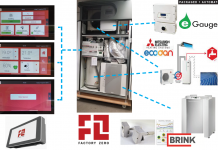Chris Williams
In the previous post on understanding the geothermal heat pump industry, we addressed (1) what’s driving the growth in the GHP industry, (2) the advantages of GHPs and (3) what market segments are adopting the technology the fastest. In this article we will continue the discussion and address:
4. The bottleneck’s to GHP continued and faster growth
5. Possible Investment targets within GHP
6. The 2 best opportunities for investment in public equities.
4. Bottlenecks: There are two major things holding back the GHP industry.
1. Technical knowledge. IGSHPA, The International Ground Source Heat Pump Association, has created a training certification to help spread the knowledge. HeatSpring Learning Institute, along with a number of other private and public education providers, is using the IGSHPA certification to build the base of industry professionals who can install geothermal.
2. Financing. Similar to the solar industry, the large amount of money upfront needed to install geothermal has impeded growth. Until the industry can figure out the financing, like the solar industry has with the PPA, growth will not be rapid. LVestus is a New Hampshire based company that is now offering a TPA, a thermal purchase agreement, and is addressing the financing issue.
If these two items are addressed, the growth of the GHP industry will be much faster than the 30% it has been for the last couple years.
5. How can you invest in this growth? Where is the opportunity in the GHP Industry?
In the solar industry, although it’s very volatile, it’s very easy to find a place to invest. There are a number of large, publicly traded manufactures that are pure plays FSLR, TSL, STP, just to name a few. There’s also a wide range of ETFs, or Exchange-Traded Funds.
The GHP industry is showing strong growth, it’s a sizable market, it’s based on solid technology, and demand will only increase over the next 30 years as our nation invests in upgrading our building infrastructure
With that said, let’s take a look at the products and services provided in every geothermal installation to see where the opportunities exist for investment.
Products and Services
- Heat Pumps – HVAC condensing/evaporate units
- Ducting Installation – Sheet metal and duct seal to deliver hot/cool air to the conditioned space from the heat pump
- Grout – Cement or bentonite based compounds used in the installation of the ground loop
- Pump Package – Standard pumps reconfigured for geothermal use to move water from the ground loop to the heat pump
- Ground Loop – Simple high-density polyethylene (HPDE) plastic installed in th ground to extract or deposit BTUs from or to the heat pump
- Design Software – Used for design of all sizes of systems
- Drill Rig – Required for drilling and installing vertical ground loops
Other than the heat pumps, the rest of the products are nearly impossible to invest in because they are:
1. Very small companies that are not large enough to become public. This pertains to most design and installation firms as well as software companies. Loop Link Geothermal design software is a great example of thisthey have great software used by many in the industry to design residential and light commercial systems, but it’s a niche play so the company remains small.
2. Commodity products. It is difficult to distinguish a commodity product’s use in geothermal applications versus other applications. For example, ducting and pump packages are used for hundreds of other HVAC applications, and it’s impossible to find a company that just sells “geothermal” ducting or pump packagesthey do not exist.
6. The only opportunity to invest in GHP is in the heat pumps themselves.
Here is a review of the top heat pump manufacturers in the USA
- Carrier Corporation/Bryant – GHP a small part of HVAC business and Carrier is a subsidiary of United Technologies Corporation (UTX)
- ClimateMaster – A subsidiary of LSB Industries (LXU), a chemical company.
- DEVI Electroheat Ltd. E – Member of the Danfos group, a Danish pump company.
- Eagle Mountain – Private manufacturing company based in New York .
- ECONAR Geosystems LLC – Part of Geosystems, which is a subsidiary of Research Products Corporation, a private company
- Energycore – A private Australian company
- Florida Heat Pump – Subsidiary of Bosch, a huge but private German corporation
- Heat Controller – A subsidiary of Century heat pumps, a private company
- Northern Heat Pump, Inc. – A subsidiary of Electro Industries, a private company
- Ochsner Heat Pumps Ltd. – A private company based in Ireland
- WaterFurnace International, Inc. – (WFI in Toronto, or WFIFF on the pink sheets) – The only pure play GHP stock.
After a review of GHP manufacturers, there are only three that are public and accessible. UTX and LXU are both large corporations where GHP probably represents less than 10% of yearly revenue. While UTX’s main business units are comprised of defense and aerospace, a minority interest is in the building industry through Carrier, where it has a stake in GHP manufacturing. LXU is less diversified than UTX and has two main business unitsclimate control and chemicals. The climate control group designs and manufactures a range of HVAC products including ground source heat pumps. WFI is the only pure play on the GHP industry.
Here’s a review of some basic metrics as of June 8th, 2011.
|
Ticker |
Revenue |
Stock Price |
ROE |
Beta |
Dividend |
Market Cap |
|
54B |
83.24 USD |
18.66% |
1.01 |
1.70 |
76B |
|
|
609M |
43.71 USD |
41.5% |
1.54 |
0 |
967M |
|
|
135M |
22.69 CAD |
67% |
– |
.83 |
27 |
In the end, I’d suggest that LXU and WFI are the only access routes to the GHP industry in public equities. Both ClimateMaster (LXU) and WaterFurance (WFI) are respected manufacturers within the industry and provide quality products.
After completing the analysis and looking at direct access to the GHP industry, I was surprised how decentralized the industry is for every product within the supply chain. Based on the number of products that go into every GHP installation, I would have thought it would be easier to invest in the industry. However, if you use Porter’s five forces analysis it becomes clear why the GHP industry is structure is so different from solar. The GHP industry as a whole is highly competitive, very price sensitive, and built around commodities instead of proprietary technology or manufacturing techniques like we see in the solar industry.
If you’re really interested in taking advantage of the GHP industry, WFI and LXU seem to be your best options. While UTX is also possible, it’s much more of a defense/aerospace play than a GHP investment.
Chris Williams is an IGSHPA certified geothermal installed and works with HeatSpring Learning Institute delivering world-class IGSHPA Geothermal Training, NABCEP Solar Training, and BPI Certification training to professionals who are installing, designing or selling renewable energy systems. Sign up for their newsletter here. Chris can be reached directly at cwilliams@heatspring.com or in the twitterverse @topherwilliams








